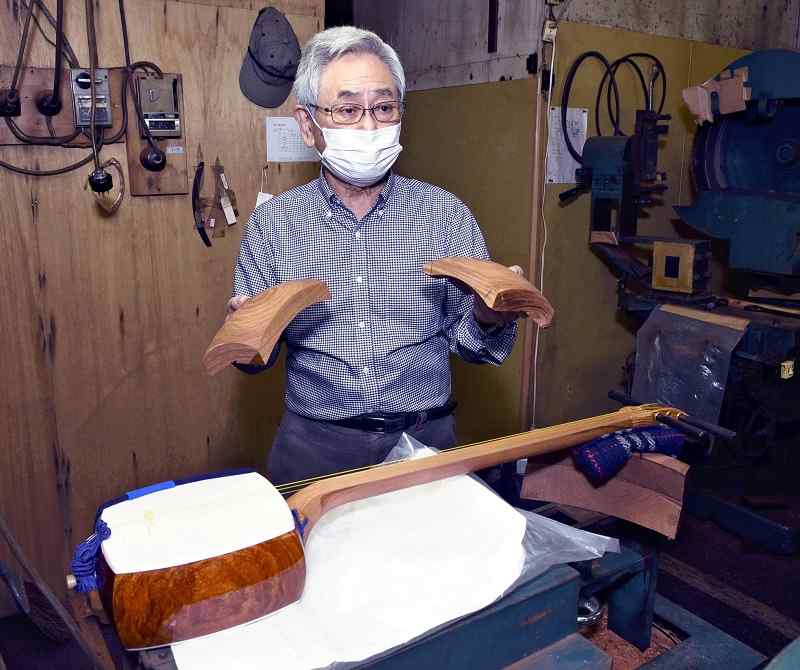
Katsuhiro Otaki, director of shamisen manufacturer Tokyo Wagakki, constructs an instrument in Hachioji, Tokyo.
16:32 JST, June 17, 2021
The Japanese traditional musical instrument industry is facing difficult times, with fewer instruments being sold as there are fewer performers to play them. To support the industry and to create more interest in traditional music, the Cultural Affairs Agency has started to lend instruments such as shamisen, koto and shakuhachi to university clubs among other measures.
Traditional Japanese music is generally called hogaku and it is deeply connected to the sensibilities of the people of Japan. As its decline may affect other types of performing arts and traditional crafts, taking measures to preserve the industry are necessary.
According to the Zenkoku Hogakki Kumiai Rengokai, a national federation of Japanese traditional musical instrument associations, the number of shamisen and koto sold annually by member businesses has significantly decreased between 1970 and 2017. In 1970, about 18,000 shamisen were sold, but in 2017, only about 3,400. For koto, the corresponding numbers were about 25,800 and about 3,900.
The coronavirus pandemic has aggravated the situation further because it has reduced the number of performances that are held.
Traditional instruments and minyo folk ballads, which are often performed accompanied by these instruments, enjoyed an increase in popularity in the 1960s and ’70s. In recent years, the marketplace has more secondhand instruments stocked than before, resulting in fewer orders for new instruments.
Tokyo Wagakki, a shamisen manufacturing company in Hachioji, Tokyo, that opened in 1885, announced last year that it was shutting down its business. The maker decided to keep its doors open, however, after the traditional instrument-wielding rock group Wagakki Band started a fundraiser to help the company survive.
“Before, we would make 350 to 400 shamisen a month,” said Katsuhiro Otaki, the 81-year-old director of the company. “But now we only make an average of about 20.”
The company has 135 machines used for shaving the wood from the body of the shamisen to give it delicate curves and to drill holes. Tokyo Wagakki designed and built these machines to make the shamisen production process easier. The company’s financial problems will directly jeopardize such valuable tools used to make musical instruments.
Silk strings used for koto and similar instruments need to be made through a special process that is different from making yarn for textiles. There have been fewer manufacturers that can make these silk strings, so recently, artificial fibers are more commonly used.
Some materials have become more difficult to obtain because of restrictions placed on international trade by the Washington Convention, including ivory, which was used to make the shamisen’s picks and the koto’s movable bridges, and wood from the red sandalwood tree, which was used to construct the neck of the shamisen.
Building these instruments requires a wide range of materials, techniques and tools, many of which are necessary for other traditional crafts as well.
“Hogaku musical instruments are used to accompany a variety of traditional performing arts, such as bunraku and kabuki,” said Megumi Maehara, head of the Intangible Cultural Properties Section at the Tokyo National Research Institute for Cultural Properties. “The preservation of hogaku instruments needs to be done in conjunction with the preservation of other traditional performing arts.”
The koto was brought over from China during the Nara period (710-784), while the shamisen has been popular since the Edo period (1603-1867). Both instruments have taken root in the lives of many people.
Composer Shinichiro Ikebe, 77, said: “People continue to feel the sounds of the shakuhachi, shamisen, koto and other hogaku instruments as ‘ma,’ the sound of silence after the last note fades away. Western instruments do not have this characteristic. To breathe in this ‘ma’ that is also found in calligraphy and Japanese painting is the easiest way to grasp this peculiar characteristic of Japanese culture.”
Hogaku is not just a genre of music. The sound and appeal of hogaku should be recognized as one of the indispensable elements that have formed the foundation of Japanese sensibility.
"Culture" POPULAR ARTICLE
-

Van Cleef & Arpels Dazzles with Art Deco Artisanry at Tokyo Exhibit
-

Disney’s ‘Twisted-Wonderland’ Animated Series Puts Villains in Spotlight: New Show Features School Inspired by Classic Disney Films
-

Ayumi Hamasaki’s Shanghai Concert Canceled Day Before Schedule as Part of Beijing Backlash
-

‘The World Masterpiece Theater Series’ Celebrates 50 Years; Animator Looks Back on Creating Anime Classics
-

Popularity of Piggy Banks Across Time and Place Seen at Bank’s Museum of Money Boxes in Hyogo Pref.
JN ACCESS RANKING
-

Tokyo Economic Security Forum to Hold Inaugural Meeting Amid Tense Global Environment
-

Keidanren Chairman Yoshinobu Tsutsui Visits Kashiwazaki-Kariwa Nuclear Power Plant; Inspects New Emergency Safety System
-

Imports of Rare Earths from China Facing Delays, May Be Caused by Deterioration of Japan-China Relations
-

University of Tokyo Professor Discusses Japanese Economic Security in Interview Ahead of Forum
-

Japan Pulls out of Vietnam Nuclear Project, Complicating Hanoi’s Power Plans























